Object Record
Images

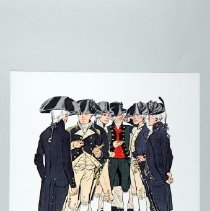
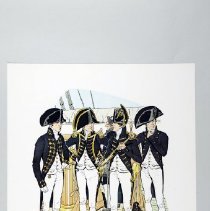
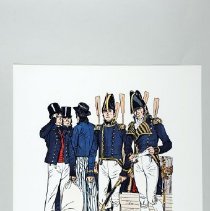
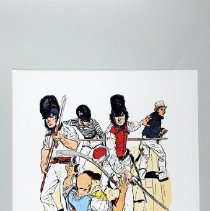
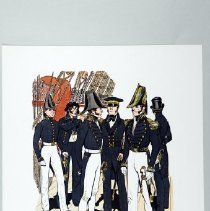
Additional Images [8]
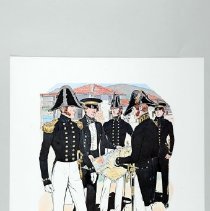

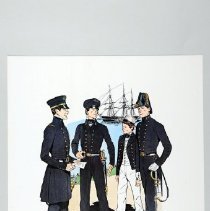
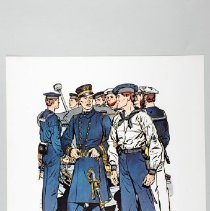
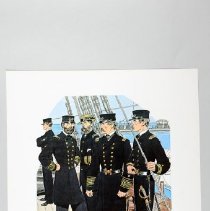
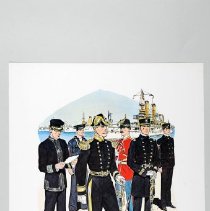

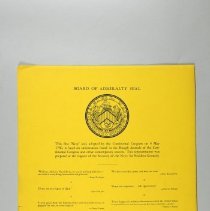
Metadata
Object Name |
|
Title |
Uniforms of the United States Navy 1776-1898 |
Catalog Number |
2014.00.252 |
Creator |
McBarron, Charles |
Date |
ca. 1966 |
Material(s) |
Paper |
Dimensions |
H-20.5 W-17 inches |
Description |
This is a print set titled "Uniforms of the United States Navy 1776-1898" which consists of twelve (12) prints depicting changes in naval uniforms during the period 1776-1898 plus one yellow folder. The prints are color artwork reproductions illustrated by Charles McBarron and published by the U.S. Government Printing Office in 1966. A. The first print is titled "CONTINENTAL NAVY-- 1776-1777" in black text at the base of the picture, which occupies the majority of the space on the poster. The background of the print features a ship bearing the American flag on its prow. The foreground features 5 men standing on the deck of another ship. Each man is labeled, in black text, with his title at the base of the photo above the title; from left to right, "Lieutenant / 1776," "Captain / 1776," "Midshipman / 1777," Captain / 1777, " and "Seaman." The lieutenant and leftmost captain wear blue uniforms faced in red, with red vests, gold buttons, white cravats and black buckled shoes. The lieutenant wears his hat while the captain holds his in his left hand to greet the second captain. The midshipman and captain both have navy blue uniforms with white vests, gold buttons, white cravats and black buckled shoes; however, the captain's coat is white faced and he wears gold accented epaulets, and his hat is in his left hand to greet the other captain while the midshipman wears his. The captains are shaking hands and both of their uniforms show gold embroidery while the others' do not. The seaman stands off the right, a little outside of the main image. He wears a flat blue hat, does not wear a powdered wig like the others, a blue coat with a blue kerchief, red vest, and baggy white pants. B. The second print is titled "UNITED STATES NAVY, 1797" at the base of the central image in black ink. There are six men in the image, each labeled with their title in black text at the base of the image. Left to right are, "Purser," "Captain," "Midshipman," "Surgeon," "Lieutenant," and "Sailing Master." In the image, the purser's back is turned to the viewer while appearing to talk to the captain, who faces to the front and towards him and holds a collapsed spyglass. The midshipman is partially hidden behind the captain and is turned to the right, but looking over his and the captain's shoulder at the viewer. The surgeon is situated at the back of the image, grinning, and holding a case of some kind in his right hand and picking his nose with his left. The lieutenant is closer to the foreground than the surgeon and is also turned sideways, facing left, but looking sideways off into the distance towards the viewer with his left hand on his sword hilt. The sailing master is also turned sideways, facing left, but his back is partially visible as he faces the rest of the group. His hands are clasped behind his back. All of the officers wear blue jackets, cream vests, cream pants, white cravats, black hats, and black buckled shoes. There are some variations: the type of sleeve (cream or blue) and the color the coat is faced in (cream or blue) and the amount/type of gold buttons. The captain is the only one wearing epaulets. The surgeon wears a green, black faced uniform with a red vest, green pants, gold buttons, a white cravat, a black hat and black buckled shoes. All men wear powdered wigs, and everyone except the purser and sailing master wear swords. At the bottom of the page, in small black lettering, is typed, "Permission to reprint and including printing for public sale by the Superintendent of Documents, Government Printing Office, courtesy of The Company of Military Historians and H. Charles McBarron." C. The third print is titled "UNITED STATES NAVY, 1802, FULL DRESS," at the base of the print, below the picture. The image features 4 men standing on the deck of a ship, talking and examining a spyglass, while a crew member steers the ship in the background behind the men. Each man has his title listed below him in black ink, underneath the image. Left to right, they are, "Surgeon," "Captain," Lieutenant," and "Purser." Although the men possess different ranks, their uniforms are very similar; the book that lists and describes the styles says that 1802, being the first year an official uniform was ordered under the signature of the Secretary of the Navy, also begins the US naval tradition of blue and white uniforms. The men all wear navy blue coats; white vests, breeches and cravats; black buckled shoes and black hats. The only variations on the uniforms is the amount and type of gold embroidery and accents, including buttons and epaulets. The captain and lieutenant each have gold embroidery on their hats, and have "laced" button holes while the others do not, and each wear at least one epaulet, although the captain wears two. Both men also wear swords. The purser has almost no embroidery, except around his collar, but the surgeon does have extensive "frogging" embroidery down the front of his coat; the frog fastener was distinct to the surgeon to mark him as such. At the bottom of the print, in small black lettering, is typed, ""Permission to reprint and including printing for public sale by the Superintendent of Documents, Government Printing Office, courtesy of The Company of Military Historians and H. Charles McBarron." D. The fourth print is titled, "UNITED STATES NAVAL OFFICERS AND SEAMEN, DRESS UNIFORMS, 1812-1815." The title, like on the other prints, is printed at the base of the image, but unlike the previous prints, the officers depicted do not have their ranks listed below them. One can assume the two men on the right are captains however, because of the embroidery on their coats and hats, and the double epaulet. Both of these men wear blue coats emboridered in gold with gold buttons, white pants, black shoes, and gold embroidered, black hats. However, the captain furthest right exemplifies an older style of dress in the shorter-waisted, tailed coat; breeches and buckled black shoes, while the captain on the left wears the newer style (signed off on by the Secretary of the Navy in 1813) of pantaloons, black boots, and a longer-waisted, but still tailed, coat. Three more men stand to the left and off to the back, wearing the general style for seamen at the time: white pants, blue coats, red vests, blue kerchiefs, and some sort of hat. As one of the sailors, whose back is turned in the image, can attest, there were variations in this style- his pants are striped. The book suggests that this was not because of any disrespect for the uniform, or to indicate rank, but because not every seaman had the means to outift himself as recommended. Regional variations also played a part. All men are standing on a dock. The officers appear to be looking over some orders, while the seamen are standing in a group of three, talking. At the base of the print is printed in black ink, "Permission to reprint and including printing for public sale by the Superintendent of Documents, Government Printing Office, courtesy of The Company of Military Historians and H. Charles McBarron." E. The fifth print is titled, "BOARDING PARTY, U.S. NAVY, 1815- NAVAL WAR WITH ALGIERS," in black ink along the base of the image. This print continues the printing of titles of those depicted in the image, so from left to right they are, "Seamen," "Algerine," and "Officer," printed in black ink below the image. There are three seamen in this image, and they are attacking an Algerine on the deck of an Algerine ship. The seamen, again, have no proscribed uniform, but did dress alike. In the image, the men all wear white pants, white shirts, black belts, and bearskin-lined tall hats. The left seaman wears a red kerchief around his waist and a black kerchief around his neck, the seaman in the background also has black stripes on his shirt, and the seaman on the right wears a red vest and has a black kerchief around his neck. The left and right seamen wear cutlasses, one of the common weapons carried by seamen, but the left and back seamen carry pikes, also common weapons. The right man is slashing a blow to the Algerine's head with his cutlass, who has fallen from the blow. The Algerine, in the foreground of the image, wears yellow baggy pants, red pointy shoes, a white shirt, blue vest, and red and white striped sash. His curved sword has fallen from his hand. An officer stands to the right background, wearing the white pants and blue coat suggested of officers. He also wears a cutlass, but carries a musket, and wears the summer version of the naval hat: a straw boater. Printed at the bottom of the print in black text is, "Permission to reprint and including printing for public sale by the Superintendent of Documents, Government Printing Office, courtesy of The Company of Military Historians and H. Charles McBarron." F. This sixth print is titled, "UNITED STATES NAVY, 1830-1841," in black text at the base of the image. The image depicts six men, three in the foreground, three in the background. Their titles are listed below them in black ink, as in the other prints. Left to right, they are, "Midshipman, Full Dress;" "Boatswain's Mate;" "Purser, Full Dress;" "Lieutenant, Undress;" "Captain, Full Dress;" and "Boatswain, Full Dress," although the text is staggered to fit all the titles. This image continues the tradition of the navy and white uniforms for the officers of the US Navy. All officers wear variations of the gold buttoned/embroidered blue coat, and some sort of hat, and while the similarities stop there, the cuts of the coats of the officers had become recommended to be the same. The midshipman wears white pants, a short-waisted coat with a white belt, and a tall black hat, while the boatswain's mate wears all blue, except for a white cummerbund, and a short, flat black hat and a black kerchief. The purser wears white breeches, a short-waisted coat with a white belt, a tall black hat and black, buckled shoes. The lieutenant wears all blue, with a blue belt, a white vest, a black cravat, and a brimmed navy hat, similar to those seen in today's navy. He wears one epaulet. The captain wears a similar uniform to that seen in 1812: white pants, blue short-waisted coat, with a blue belt, and much gold embroidery. He also wears two epaulets and a gold-accented, black hat. The boatswain's back is turned, but it's evident that he wears all blue, and a black top hat. All men wear swords, except for maybe the boatswain's mate, although his waist is not visible to the viewer. The men stand on a ship's deck and the purser, lieutenant and captain are all in conversation in the foreground, while the midshipman looks at the viewer, and the boatswain's mate calls to the boatswain, who looks back off into the distance, all in the background. Printed at the base of the print, in black lettering, is, "Permission to reprint and including printing for public sale by the Superintendent of Documents, Government Printing Office, courtesy of The Company of Military Historians and H. Charles McBarron." G. The words "UNITED STATES NAVY, 1841," are printed in black at the base of the seventh print in this collection. Again, the men's titles appear below their image in black ink. Left to right they are, "Commodore / Full Dress," "Purser / Undress," "Surgeon / Full Dress," Lieutenant / Full Dress," and "1st Ass't Engineer / Full Dress." The officers depicted here are standing in front of a group of white houses, and are staggered, with the commodore, facing right and looking at the lieutenant, and the lieutenant, facing back left and examining a map, in the foreground; the purser in middleground, facing the lieutenant (forward right) and holding the map out to him; and the surgeon and 1st Ass't Engineer facing forwards toward the others in the background. The US naval tradition of blue and white continues in this image as well. The men all wear navy coats, long pants and hats. However, the purser, being the only one in undress, wears the frock coat whereas the rest of the officers wear tailed, short-waisted coats with double parallel lines of gold buttons down the front. The purser also wear a white vest and shirt, navy pants, a black kerchief, black shoes and a flat, brimmed black hat with a cap band of gold running above the brim. He wears no sword or gloves. The other man wearing navy blue pants, the 1st Ass't Engineer, also wears the same gold-banded and brimmed short black hat. His coat collar has 2 silver stars, one on each side, to signify his position as 1st Ass't Engineer, and he wears a black cravat, black shoes and a sword. Note that the navy pants are not necesarily a sign of rank: the book says that all men could choose between the white and navy pants depending on the situation and "at the discretion of [their] commanding officer." The other three officers, the commodore, the surgeon, and the lieutenant, all wear white pants, the double row-buttoned navy coat, black shoes, black cravats, swords, and tall black hats decorated with bullion fringe on the sides. The only distinguishing marks on the men are the commodore's gold epaulets, fringed and stamped with a silver star and eagle; the surgeon's collar decoration of 3 gold sprigs of live oak; and the lieutnenat's elaborate gold collar embroidery. The commodore and lieutenant wear white gloves, and the surgeon's hands aren't visible. In the far background is a group of 3 men in the commissioned white, blue-collared, uniform of the other enlisted men. H. The eighth print is titled "UNITED STATES NAVY, 1852," in black ink at the base of the image. Above the title are the officers' titles, also in black ink, and left to right they are, "Surgeon / Undress," "Lieutenant / White Service," "Boatswain's Mate," "Captain / Full Dress," and "Chief Engineer / Service Dress." The image itself depicts the five men standing on the bank next to a bay in which 2 US Naval vessels are floating. The boatswain's mate and chief engineer stand to the back of the group, while the other three stand in the front, with the surgeon furthest in the foreground and his back partially turned to the viewer and the lieutenant standing in profile, facing to the right. The uniforms here are all different, and a completely white uniform has been introduced on the lieutenant, to be worn in warm-weather climates. The lieutenant's white uniform is double-breasted with gold buttons, and he also wears a black cravat and black shoes. The signs of his office are the gold shoulder straps bearing the horizontal silver anchor, and his hat, which holds an oak and olive wreath and horizontal anchor as well as a gold cap band above the black brim. The other officers all wear a variation on the all navy uniform. The surgeon wears the undress frock coat with gold buttons and gold shoulder straps containing the letters "M.D." with an acorn on either side that signify him as a senior officer of the Medical Department. He also wears black shoes, white gloves, and a tall black hat with gray and gold bullions. The captain also wears a navy blue uniform, but with quite a bit of gold embroidery and accentuation. The book says, "The captain in full dress is identified by the three strips of the three-quarter inch lace around his cuffs, and by the inches and a half wide lace around the top of the collar and down the seams of his trousers." This image depicts the captain's uniform as such. The captain's coat is tailess and short-waisted; he pairs it with a gold-buckled, black belt. He also wears gold, fringed epaulets with the silver eagle and star, as well as black shoes, white gloves, a sword and a black tall hat with gray and gold bullions. The chief engineer also wears the all navy uniform, although in a single-breasted coat that falls to mid-thigh. He too, wears a black belt, black shoes, sword and white gloves. His shoulder straps are gold with the "E" signifying him as a member of the Engineers, and his flat, blue hat has a gold cap band and the Engineer Corps' device, a gold wheel and a silver anchor surrounded by a wreath of oak and olive leaves. The last man to be wearing an all navy uniform, the boatswain's mate also has a different style of uniform than the others. He wears a blue frock coat with a white collar and blue-striped white cuffs. The eagle and star device on his right sleeve identify him as a petty officer. His collar is stitched in blue with two blue stars on either side, and he wears a blue kerchief, black shoes, a black boater, and carries a silver whistle that hangs from a silver chain around his neck. I. The ninth print depicts a semi-circle of officers and a boy standing in front of a bay containing the U.S.S. Constellation [name in italics], and is titled, "MIDSHIPMEN, 1852-1855," in black ink at the base of the image. The three officers' titles are typed left to right below them: "Passed Midshipman, Undress," "Midshipman, Service Dress, " and "Midshipman, Full Dress." The boy stands third from left, between the service dressed and full dressed midshipmen. All midshipmen wear solid navy uniforms, but aside from matching navy trousers, black cravats, black shoes, and swords, all similarity stops there. The undress coat is a frock coat, reaching to just above the knees, with thin gold shoulder straps, which could only be worn by passed midshipman, not the unpassed. He wears a gold-buckled, black belt and the short, flat navy hat with a thin gold cap band above the black brim. The hat also has a device of a wreath of olive and oak branches around a silver foul anchor. The passed midshipman also carries a sheet of paper. The service-dressed midshipman stands to the passed midshipman's left and has his right hand on his belt. He represents the variations on the normal midshipman's uniform presented by the Naval Academy. His jacket (NOT coat, which was more cumbersome) is double breasted, with two rows of gold buttons own the front. Two gold foul anchors are displayed on either side of his collar, and his gold-buckled, black belt is imprinted with "US." His navy hat is worn without the grommet (which makes the cap flat and stiff on top) to give it a "more natuical flair," and has no cap band. However, it does have a horizontal silver foul anchor device. The midshipman in full dress wears a navy short-waisted, tailed, single-breasted coat with a standing collar emboridered on either side with a gold foul anchor and two double rows of gold buttons down the front. He also wears a gold-buckled, black belt, but different from the others, wears white gloves and a tall black hat decorated with gold and black bullion. Lastly, the "plebe," or first year man (the boy), wears an open double breasted coat, a white vest, black cravat, black shoes and the white pants and straw boater common in warm-weather uniforms. Printed at the base of the print, in black lettering, is, "Permission to reprint and including printing for public sale by the Superintendent of Documents, Government Printing Office, courtesy of The Company of Military Historians and H. Charles McBarron." J. In the tenth image, a lieutenant and petty officer, talking, stand in front of the group of blue and white clad seamen that make up the gun crew, who are examining a gun. Left to right, the titles, again in black ink, listed under the image are, "Seaman," "Lieutenant," and "Petty Officer." The seamen mostly wear the same style of dress: jacket, kerchief, trousers, and flat cap, although the navy and white coloring of each varies. The image is titled, "U.S. NAVY, SERVICE DRESS, 1862-1863," in black underneath the image. The lieutenant wears a navy, double breasted, knee-length coat with two rows of gold buttons down the front; navy trousers; a gold-buckled, black belt; black shoes; sword and a black cravat. He has two gold bands of lace on his sleeves, one thick and the other thin, and two gold shoulder straps. His flat navy hat has a gold cap band above the black brim and the junior officers' device: the wreath of olive and oak branches around a foul anchor. The petty officer wears a white frock with blue- faced collars and cuffs, with the left sleeve bearing a blue star with an eagle over a foul anchor, the mark of all petty officers. He wears a black kerchief under his collar; a black belt; black shoes; a navy, gray edged cap; a pistol and a canteen. Printed at the base of the print, in black lettering, is, "Permission to reprint and including printing for public sale by the Superintendent of Documents, Government Printing Office, courtesy of The Company of Military Historians and H. Charles McBarron." K. The eleventh print is titled, "UNITED STATES NAVY, 1864, SERVICE DRESS," in black ink below an image depicting 5 officers on the deck of a ship. Behind them is a Civil War-era ironclad. Left to right, their titles, again printed below them in black ink, are, "Master-at-Arms," "Fleet Engineer," "Fleet Surgeon," "Rear Admiral," and "Lieutenant," and left to right, they are shown arranged from the background to the foreground (with the master-at-arms furthermost in the back and the lieutenant furthest to the front). All wear solid navy uniforms, but with varying degrees of ornamentation and length of coat. The master-at-arms is marked as a petty officer by the white star and eagle/foul anchor design on the sleeve of his waist-length coat. He wears a flat, black brimmed hat, black shoes and a black cravat and faces to the left. The fleet engineer wears a double-breasted, knee-length coat with a double row of gold buttons down the front, and two sets of 3 bands of lace on each sleeve. He also wears two navy, gold edged shoulder straps, as well as a black cravat and black shoes. His flat, brimmed hat bears the wreathed, foul-anchor device. The fleet surgeon wears a navy mid-thigh length "sack" coat, with four gold buttons down the front. He also has two sets of 3 bands of lace on each sleeve as well as two navy, gold-edged shoulder straps. He has a hankerchief in his breast pocket, and wears black shoes and a straw boater typical with warm weather. The rear admiral wears a double breasted, knee length coat with two rows of gold buttons down the front, but with nine bands of lace on each sleeve, topped with a gold star. He wears a gold-buckled, black belt as well as black shoes, a black cravat and a sword. His shoulder straps are also navy and gold-edged but contain three white stars instead of the corps device. His hat is flat and black brimmed but his olive and oak wreath surrounds 2 white stars. Lastly, the lieutenant wears a double-breasted waist-length coat with two rows of gold buttons down the front, 3 bands of lace topped with a gold star on each sleeve, and two navy, gold-edged shoulder straps containing two gold bands and a foul anchor. He also wears a gold-buckled, black belt with a sword, a black cravat and a black-brimmed, flat hat. However, his olive and oak wreath surrounds the horizontal foul anchor. None of the men wear gloves. L. The final and twelfth print is titled, "UNITED STATES NAVY, 1898," in black ink at the bottom of the print. A group of 6 men stand on a dock in front of a fleet of three US Naval vessels, which the book says represent, left to right, the Protected Cruiser Columbus [last in italics], Armored Cruiser Brooklyn [last in italics], and the Battleship Iowa [last in italics]. Once again, the titles of the officers are listed under their images. From left to right on the dock: "Captain, Civil Engineer Corps / Service Dress;" "Boatswain's Mate / 1st Class;" "Rear Admiral / Special Full Dress;" "Bandmaster / Full Dress;" "Commander / Undress;" and "Chief / Master at Arms." The titles are staggered to fit them across the page. The uniforms worn in this image are all very different from one another. The captain of the Civil Engineer Corps wears the service dress that replaced the sack coat from the Civil War: a navy blue coat with edged collar, front, and bottom. The sleeves give an indication to his position: the gold lace is interspersed with a light blue velvet, the color assigned to the civil engineers. To show his rank as captain, he wears a silver eagle on his standing collar in front of the civil engineers' corps device of "C.E.," written in Old English. His hat bears a gold cap band and a gold-edged cap brim, as well as the device of all commisioned officers: the silver eagle and shield with two crossed foul anchors. He also wears black shoes, navy trousers, and a white shirt under his jacket. In the image, he is facing right, looking at a piece of paper in his hands. To his back left, the boatswain's mate wears the traditional navy frock with kerchief over a white shirt, navy trousers, black shoes and flat blue cap. The changes are the device on his right sleeve (an indication he's a member of the starboard watch), a set of 3 chevrons with the petty officer eagle crest above and the "USS [unreadable]" in white on the front of his cap. Next, the rear admiral stands in the immediate foreground of the image. He wears a completely navy blue uniform of a tailed body coat and trousers with the gold lace on the standing collar and trouser seams measuring 1.75" wide. The sleeve lace is two inches wide, with another band a half inch wide above it, and above all, a gold, five-pointed star. The rear admiral's coat also has two rows of gold buttons down the front, and two fringed, gold epaulets with silver foul anchors. With these, he wears a gold buckled, blue and gold striped belt; a gold-embroidered, cocked hat; white gloves; black shoes; a white shirt under the coat and a sword. To the rear admiral's back left is the bandmaster. His uniform is a complete change from the traditional navy and white of the US Navy, because his single-breasted coat is a bright red, trimmed in yellow and white, with gold shoulder knots and white buttons, and his pants are sky blue trimmed in the same bright red. He wears a gold-buckled, white belt, and a black, gold-trimmed helmet with a metal spike at the top. The Army's crest is present on the helmet, but with a silver lyre superimposed over the top. The bandmaster faces left with his hands clasped in front of him. To his front left is the commander, whose uniform returns to the navy and white tradition. Over a white shirt, he wears a navy, mid-thigh length, frock coat with two rows of gold buttons down the front. His sleeves are decorated with 3 bands of gold lace over which is set a gold, five-pointed star, and his shoulders bear navy, gold embroidered shoulder straps. He also wears a black, gold-buckled belt; navy trousers; black shoes; white gloves; a sword and a navy, flat, brimmed hat. The hat bears a gold cap band and a brim device of oak wreaths. The hat also bears the commisioned officer device of eagle and shield with crossed foul anchors. The commander stands facing front right, with his hands resting on his sword. Lastly, to his back left stands the chief master at arms, who stands at attention facing the front right. He wears a double-breasted sack coat with two rows of four gold buttons down the front, over a white coat and black cravat. On his right sleeve (starboard watch), he bears the triple chevron of the petty officers, this time with a white star inset under a red arc on which a white eagle is "perched." He also wears black shoes, navy trousers, and a navy flat, brimmed hat. The device on the hat is a silver foul anchor with the letters "U.S.N." superimposed over it. All prints are signed at the middle base of each image with a black signature: "H. CHARLES / McBARRON." M. This is the yellow folder that houses the prints. On the front, it reads, in black ink, "UNIFORMS / OF THE / UNITED STATES NAVY / 1776-1898." Below this is the black seal of the United States Naval Department as it was in 1966. At the bottom of the folder is typed, again, in black, "NAVAL HISTORY DIVISION / OFFICE OF THE CHIEF OF NAVAL OPERATIONS / WASHINGTON, D.C. 20360 / 1966." On the back, in more black ink, is typed "BOARD OF ADMIRALTY SEAL." That seal is printed below the title, and underneath that is the description of the seal: "This first "Navy" seal, adopted by the Continental Congress on 4 May / 1780, is based on information found in the Rough Journals of the Con- / tinental Congress and other contemporary sources. This representation was / prepared at the request of the Secretary of the Navy for President Kennedy." A small black line separates this text from two columns of quotes regarding the US navy. The left column reads, "'Without a decisive naval force, we can do nothing definitive- / and with it everything honourable and glorious.' / -George Washington [italics] / 'I have not yet begun to fight.' / -John Paul Jones [italics] / 'I wish peace from the bottom of my soul, but desire to see us / prepared for war, in every respect.' / -Thomas Truxtun [italics] / 'Don't give up the ship.' - James Lawrence [italics]." The right column reads, "' We have met the enemy and they are ours.' / -Oliver Hazard Perry [itlaics] / 'Damn the torpedoes...full speed ahead.' / - David G. Farragut [italics] / 'Every danger of a military character to which the United States / is exposed can be met best outside her own territory- at sea.' / -Alfred T.Mahan [italics] / 'You may fire when ready, Gridley.' / -George Dewey [italics]." Each quote in both columns is separated by a small black anchor. |
Subjects |
Uniforms Military uniforms |
Search Terms |
US Navy U.S. Navy Uniform Hat uniform shirt uniform vest Uniforms Navy Navy Uniform |